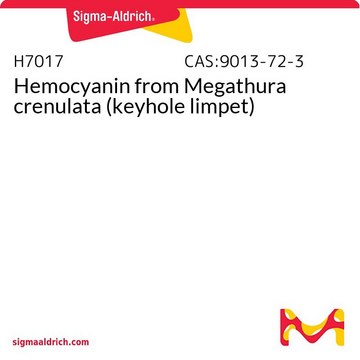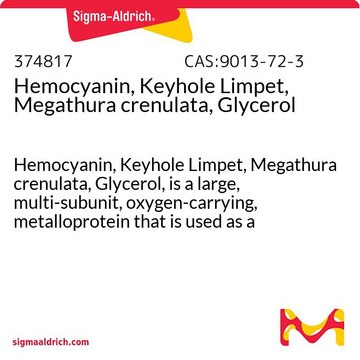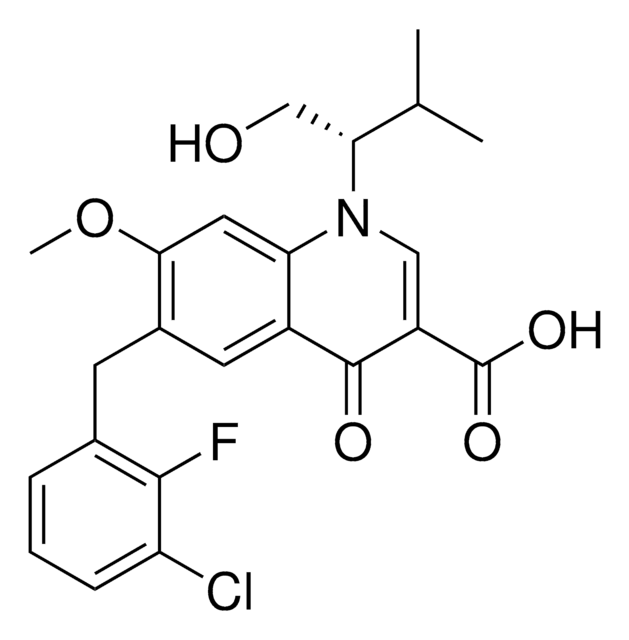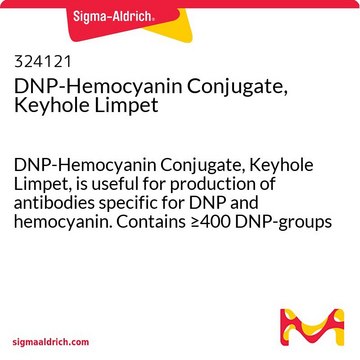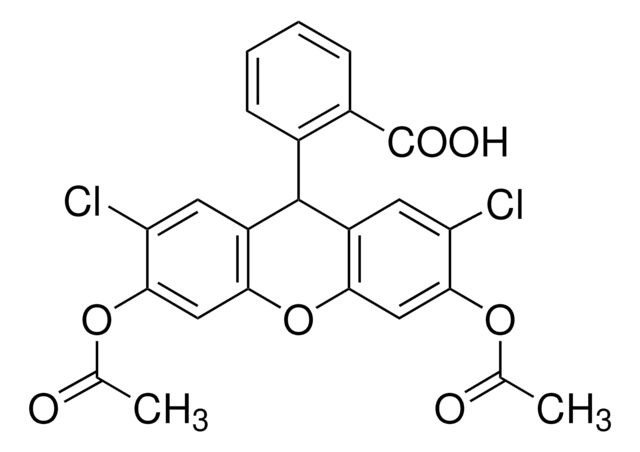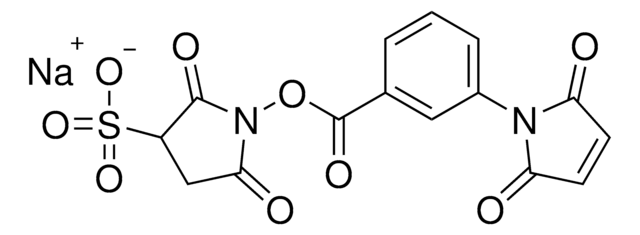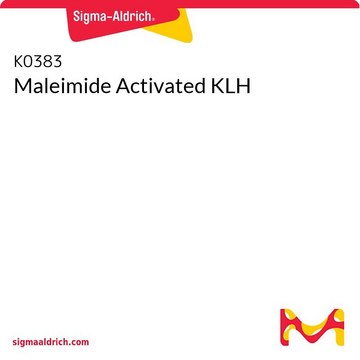SRP6195
Hemocyanin-Keyhole Limpet, Native
Synonym(s):
Megathura crenulata hemocyanin, keyhole limpett hemocyanin
Sign Into View Organizational & Contract Pricing
All Photos(1)
About This Item
UNSPSC Code:
12352202
NACRES:
NA.32
Recommended Products
Assay
≥95%
form
liquid
mol wt
370 kDa (One major band)
packaging
pkg of 25 mg
concentration
25 mg/vial
shipped in
wet ice
storage temp.
2-8°C
General description
Hemocyanins are proteins that use copper binding sites to bind and transport oxygen in a variety of arthropods and mollusks. Hemocyanin is isolated from the hemolymph of the animals. Hemocyanin is one of the strongest antigens known. Hemocyanin has been in use as an immunological reagent for many years. It is used as a carrier protein for antibody production against antigens. Recent advances in immunology and the role immune system plays in diseases have opened a whole new era of product development activities aimed at developing novel therapeutics for teaching the body′s immune system to fight diseases. The approach involves the use of highly immunogenic molecule like the hemocyanin for non-specific immunostimulation (NSI) or active specific immunostimulation (ASI) using conjugate vaccines, wherein the tumor (disease) specific antigens are covalently bound to carrier protein like KLH and the product used in human clinical studies. Thenative KLH has low endotoxin content and consistent high concentration in a phosphate buffer containing no extraneous metal ions for product stabilization, however with improved stability. This research grade material is suited for use in vaccine product development activities and also for routine immunological studies, antibody production, production of activated KLH and other developmental activities.
Hemocyanins are proteins that use copper binding sites to bind and transport oxygen in a variety of arthropods and mollusks. Hemocyanin is isolated from the hemolymph of the animals.
Hemocyanin is one of the strongest antigens known. Hemocyanin has been in use as an immunological reagent for many years. It is used as a carrier protein for antibody production against antigens. Recent advances in immunology and the role immune system plays in diseases have opened a whole new era of product development activities aimed at developing novel therapeutics for teaching the body′s immune system to fight diseases. The approach involves the use of highly immunogenic molecule like the hemocyanin for non-specific immunostimulation (NSI) or active specific immunostimulation (ASI) using conjugate vaccines, wherein the tumor (disease) specific antigens are covalently bound to carrier protein like KLH and the product used in human clinical studies. Thenative KLH has low endotoxin content and consistent high concentration in a phosphate buffer containing no extraneous metal ions for product stabilization, however with improved stability. This research grade material is suited for use in vaccine product development activities and also for routine immunological studies, antibody production, production of activated KLH and other developmental activities.
Keyhole limpet hemocyanin (KLH) is a copper-containing extracellular respiratory protein found in the marine gastropod Megathura crenulata. This protein exists in two isoforms- KLH1 and KLH2. In few pulmonate gastropods this protein is synthesized by connective tissue “pore cells”, where KLH resides as cylindrical macromolecules and even forms intracellular crystalline arrays in the endoplasmic reticulum cisternae. It belongs to the hemocyanin protein family which are found in the hemolymph of many molluscs and arthropods.
Hemocyanin is one of the strongest antigens known. Hemocyanin has been in use as an immunological reagent for many years. It is used as a carrier protein for antibody production against antigens. Recent advances in immunology and the role immune system plays in diseases have opened a whole new era of product development activities aimed at developing novel therapeutics for teaching the body′s immune system to fight diseases. The approach involves the use of highly immunogenic molecule like the hemocyanin for non-specific immunostimulation (NSI) or active specific immunostimulation (ASI) using conjugate vaccines, wherein the tumor (disease) specific antigens are covalently bound to carrier protein like KLH and the product used in human clinical studies. Thenative KLH has low endotoxin content and consistent high concentration in a phosphate buffer containing no extraneous metal ions for product stabilization, however with improved stability. This research grade material is suited for use in vaccine product development activities and also for routine immunological studies, antibody production, production of activated KLH and other developmental activities.
Keyhole limpet hemocyanin (KLH) is a copper-containing extracellular respiratory protein found in the marine gastropod Megathura crenulata. This protein exists in two isoforms- KLH1 and KLH2. In few pulmonate gastropods this protein is synthesized by connective tissue “pore cells”, where KLH resides as cylindrical macromolecules and even forms intracellular crystalline arrays in the endoplasmic reticulum cisternae. It belongs to the hemocyanin protein family which are found in the hemolymph of many molluscs and arthropods.
Keyhole limpet hemocyanin (KLH) is a copper-containing extracellular respiratory protein found in the marine gastropod Megathura crenulata. This protein exists in two isoforms- KLH1 and KLH2. In few pulmonate gastropods this protein is synthesized by connective tissue “pore cells”, where KLH resides as cylindrical macromolecules and even forms intracellular crystalline arrays in the endoplasmic reticulum cisternae. It belongs to the hemocyanin protein family which are found in the hemolymph of many molluscs and arthropods.
Biochem/physiol Actions
In invertebrates, hemocyanin plays the role of haemoglobin as a protein that senses, stores and transports oxygen. Hemocyanin is known to be an essential protein in the immune system of the arthropods. Clotting proteins, proteases, lipoproteins, phospholipids, AMPs (adenosine monophosphate) and microbial proteases and ligands stimulate the action of hemocyanins. It offers protection against parasitism, infection,viremia and physical damages. Hemocyanin has been used to treat cancer as it can induce an immune response.
Keyhole limpet hemocyanin (KLH) is a hemocyanin, and its main function is oxygen uptake, transport and release. Hemocyanins exist as oligomers with one or more subunit types. The protein subunit contains the FU (functional unit), which contains a binuclear copper binding site that is capable of binding oxygen. It has potent immunostimulatory properties in animals and human. This protein finds major clinical use in the treatment of bladder carcinoma. It finds use as a carrier for carcinoma ganglioside and mucin-like epitopes, and has potential for the treatment of various carcinomas, particularly epithelially derived adenocarcinoma.
Physical form
25 mg in opalescent blue liquid which may contain some particulate and fibers.
Storage Class Code
10 - Combustible liquids
WGK
WGK 3
Flash Point(F)
Not applicable
Flash Point(C)
Not applicable
Choose from one of the most recent versions:
Certificates of Analysis (COA)
Lot/Batch Number
Don't see the Right Version?
If you require a particular version, you can look up a specific certificate by the Lot or Batch number.
Already Own This Product?
Find documentation for the products that you have recently purchased in the Document Library.
Ludmila Gerlinskaya et al.
Reproduction (Cambridge, England), 160(1), 117-127 (2020-06-03)
The life-history theory suggests that parental experience of the environment is passed to offspring, which allows them to adapt to prevailing conditions. This idea is supported from the mother's side, but to a much less extent from the father's side.
Immunological properties of oxygen-transport proteins: hemoglobin, hemocyanin and hemerythrin.
Coates C J and Decker H
Cellular and Molecular Life Sciences, 74(2), 293-317 (2017)
Keyhole limpet hemocyanin (KLH): a biomedical review.
Harris JR1 and Markl J
Micron (Oxford, England : 1993), 30(6), 597-623 (1999)
Structure of keyhole limpet hemocyanin type 1 (KLH1) at 15 A resolution by electron cryomicroscopy and angular reconstitution.
Orlova EV, et al.
Journal of Molecular Biology, 271(3), 417-437 (1997)
Galina Vladimirovna Kontsevaya et al.
International journal of molecular sciences, 22(19) (2021-10-14)
The latest vaccination campaign has actualized the potential impact of antigenic stimuli on reproductive functions. To address this, we mimicked vaccination's effects by administering keyhole limpet hemocyanin (KLH ) to CD1 male mice and used their sperm for in vitro
Our team of scientists has experience in all areas of research including Life Science, Material Science, Chemical Synthesis, Chromatography, Analytical and many others.
Contact Technical Service